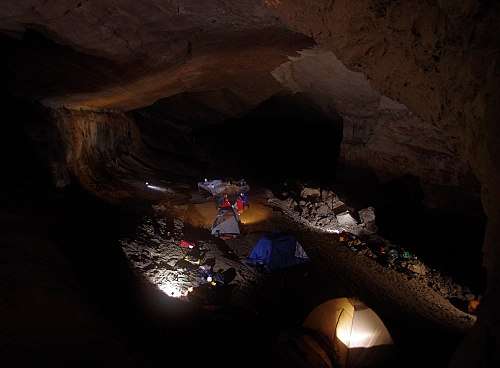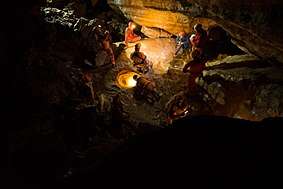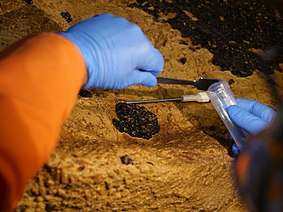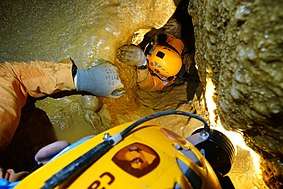ESA CAVES
CAVES, an acronym for Cooperative Adventure for Valuing and Exercising human behaviour and performance Skills, is a European Space Agency astronaut training course in which international astronauts train in a space-analogue cave environment.[1] The course is designed at the European Astronaut Center to prepare astronauts for safe and efficient long duration spaceflight operations by means of a realistic scientific and exploration mission within a multicultural, ISS-representative team.

Each training implementation last for approximately two weeks. In the first week, the so-called "cavenauts" are provided with the necessary scientific knowledge and technical skills to work effectively and safely in the underground environment and visit some simple caves to get acquainted with the condition they will find during their expedition. Afterwards, they spend six uninterrupted days exploring a complex cave system. The main purpose of the mission is to foster their communication, decision-making, problem-solving, leadership and team dynamics capabilities by means of team processes and a real crew mission performed in a space-like environment.[2][3]
Location
CAVES takes place in several caves in the Italian island of Sardinia, part of a Karst System which lie within the Supramonte region of the Gennargentu National Park. Rocks most commonly found in the area are limestone and dolomite.[4]
Objectives

The CAVES training uphold the following training objectives for participants:
- Working together effectively in a challenging environment,
- Adapting to a lack of comfort and privacy,
- Exploring the cave,
- Conducting scientific and technological research,
- Managing logistical problems and coping with limited resources,
- Facing the psychological effects of the mission,
- Handling critical situations,
- Being aware of safety requirements at all times,
- Training the participants in leadership skills.[4]
A space analogue

The cave environment is an exceptional space analogue, as it allows to recreate, on Earth, most of the stress elements and specific characteristics encountered in long duration spaceflight. Such peculiar elements include:
- Unknown / unfamiliar environment – The crew knows about the cave only what previous expeditions have found and documented
- Permanent darkness / need for artificial illumination
- Lack of time parameters – This is a direct consequence of the condition of permanent darkness in the cave
- Alteration of circadian rhythm and sleep disturbance – The lack of time references and limited facilities affect sleep quality and cycles length
- Sensory alteration / deprivation – Not only caves are lightless, they also provide almost no auditory or olfactory stimuli
- Limited privacy – Small, confined spaces do not offer much room for privacy or to keep spaces between team members
- Social and cultural aspects / crew size – The team includes with astronauts from ESA, NASA, ROSCOSMOS, CSA, JAXA and CNSA, so the team dynamics that emerge during the mission are similar to those expected on an international cooperative space mission
- Limited resources / hygiene – The transportation logistics inside the cave is extremely complex, only limited supplies can be carried inside
- Isolation / Limited communication with outside world – The crew can only rely on a telephone line up to just beyond the basecamp or radio devices working only in specific locations
 Astronaut in a squeeze during the caves training.
Astronaut in a squeeze during the caves training. - Large level of autonomy – This is a direct consequence of the isolation condition, the crew need to operate with minimal inputs from outside
- Real physical danger – Even implementing all reasonable safety measures, caves still present risks of falling, slipping, rocks tumbling down, being blocked by landslides and floodings, and participants need to pay constant attention to these aspects
- Limited mission abort / rescue capabilities – Given the complexity of the environment, both evacuation and rescue operations require several hours or even days to plan
Another analogue aspect concerns astronauts progression, i.e. how they move inside the cave. The employed speleological techniques involve safety principles similar to that of EVA, such as the need to be attached to a safe surface – the cave wall in CAVES, the ISS or the vehicle in space. Last, the crew mission performed during the exploration has several elements in common with the ISS operations, including a time-lined sequence of activities, daily planning calls to the ground support team, standardized procedures and data collection forms.
Crew mission
In the same way astronauts in space spend a consistent part of their time doing science, cavenauts are tasked to perform a real crew mission comprising several different experiments and activities while exploring the cave. Conducting scientific and technological research is the secondary objectives of the CAVES course, in addition to team training. A third one consists in exploring and documenting previously unknown areas of the cave.
Mission programme
Geology (analysis of water chemical and physical properties, counting of drip rate)
Environment (measurement of temperature / relative humidity / wind / pressure / CO2 concentration / radon concentration)

Microbiology (sampling of micro-organisms in soil and on surfaces for later cultivation)
Biology (counting and sampling of cave terrestrial and aquatic fauna, search for micro-crustaceans, search for fauna in the soil)
Technology testing (underground communication devices, physiology sensors)
Cave documentation (photos and 3D survey of the cave, photogrammetry modeling of relevant speleothems)
Results
One of the most remarkable scientific results is the discovery of a previously unknown species of crustaceans of the genus Alpioniscus living in the cave.[5]
All other results are available on the ESA Erasmus Experiment Archive, divided by year:
EEA CAVES 2011, EEA CAVES 2012, EEA CAVES 2013, EEA CAVES 2014, EEA CAVES 2016
Participants
Different roles and responsibilities are assigned to the participants for the mission, according to their background, experience and interests.
Possible roles, in line with the mission programme, include: mission commander, camp site manager, biologist, scientist, data engineer, photo engineer and survey engineer.
All participants are astronauts – either veteran or rookies – unless otherwise mentioned.
CAVES 2011
- Randolph Bresnik – NASA
- Sergey Ryzhikov – Roscosmos
- Norishige Kanai – JAXA
- Tim Peake – ESA
- Thomas Pesquet – ESA[6][7]
CAVES 2012
- Michael Fincke – NASA
- Andrew Feustel – NASA
- Nikolai Tikhonov – Roscosmos
- Soichi Noguchi – JAXA
- David Saint-Jacques – CSA
- Andreas Mogensen – ESA[8][9]
CAVES 2013
- Jeremy Hansen – CSA
- Mike Barratt – NASA
- Jack Fischer – NASA
- Aleksei Ovchinin – Roscosmos
- Satoshi Furukawa – JAXA
- Paolo Nespoli – ESA[2]
CAVES 2014
- Scott Tingle – NASA
- Alexander Mirsurkin – Roscosmos
- Sergei Kud-Sverchkov – Roscosmos
- Luca Parmitano – ESA
- Matthias Maurer – ESA (Eurocom at the time, since 2015 Astronaut)[10][11]
CAVES 2016
- Jessica Meir – NASA
- Ricky Arnold – NASA
- Sergei Korsakov – Roscosmos
- Aki Hoshide – JAXA
- Ye Guangfu – CNSA
- Pedro Duque – ESA[1][12][13][14]
CAVES 2019
- Joe Acaba- NASA
- Jeanette Epps- NASA
- Joshua Kutryk- CSA
- Alexander Gerst- ESA
- Takuya Onishi- JAXA
- Nikolai Chub- Roscosmos
See also
- Astronaut training
- Extreme environments
- Neemo
- Space exploration
- Terrestrial space analogues
References
- Park, William (November 30, 2016). "Why caves are the best place to train astronauts". BBC. Retrieved 2017-01-30.
- Howell, Elisabeth (October 5, 2013). "Astronauts Emerge from Cave After Underground Spaceflight Training". Space.com. Retrieved 2017-01-30.
- Thompson, Amy. "Why NASA Astronauts Just Spent A Week Living In A Cave". Popular Science. Retrieved 2017-01-31.
- "CAVES Information Kit" (PDF). ESA. 2012.
- "Underground astronauts preparing for space". Retrieved 2017-01-30 – via phys.org.
- Chow, Denise (November 2, 2011). "Cave Astronauts Explore Deep Inside Earth to Simulate Spaceflight". Space.com. Retrieved 2017-01-30.
- "Seeing the light: Astronauts "cave crew" returns to Earth". 2011-10-20. Retrieved 2017-01-31 – via CBSnews.
- Cowing, Keith (September 11, 2012). "ESA's CAVES: Going Underground – SpaceRef". spaceref.com. Retrieved 2017-01-30.
- Horne, Rebecca (September 11, 2012). "Spacemen Underground". WSJ. Retrieved 2017-01-30.
- "ESA's five 'cavenauts' set to explore the caves of Sardinia, Italy". September 15, 2014. Retrieved 2017-01-30.
- O'Connell, Claire (August 22, 2014). "To prepare for outer space, astronauts go underground". The Irish Times. Retrieved 2017-01-30.
- Ybanez, Alvin (July 21, 2016). "Chinese Astronaut Re-emerges from ESA Cave Training Mission". Yibada English. Retrieved 2017-01-30.
- Jones, Andrew (June 23, 2016). "NASA and Chinese astronauts set to work together on historic mission with ESA". gbtimes.com. Retrieved 2017-01-30.
- "Astronauts prep for space by living in caves". CNNMoney. Retrieved 2017-02-15.
- http://blogs.esa.int/caves/2019/09/14/a-dress-code-for-the-cave/